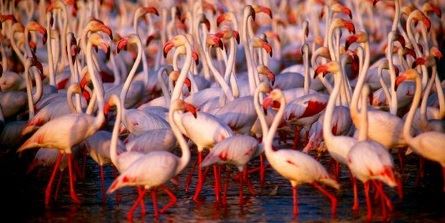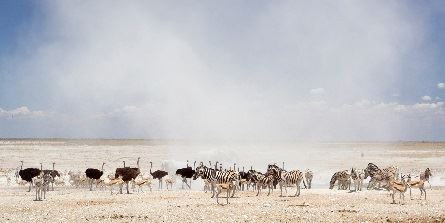The Etosha Pan is a large endorheic salt pan, covering almost a quarter of the Etosha National Park, forming part of the Kalahari Basin in the north of Namibia.
The park was proclaimed a reserve on March 22, 1907, and covers 22 270 square kilometres.
It is the largest salt pan in Africa and is the Etosha National Park’s most distinctive feature, visible even from space. It is a designated as a World Wildlife Fund Ecoregion

Etosha translates into ‘great white place’ in the language of the Ovambo tribe.
This natural mineral pan is believed to have first formed over 100 million years ago. Around 16 000 years ago, the Cunene River in Angola would have flowed to Etosha, forming a large lake. The river’s course would change later, due to tectonic plate movement, heading for the Atlantic, causing the lake to dry up slowly, and resulting in the salt pan left behind.

The salt pan contains very little vegetation; however the surrounding area is covered in grasslands where a variety of grazing animals can be seen, mainly during the wet season.

Brenda Vos, Communications Manager for Rovos Rail, commenting on why travellers choose to visit the Etosha Pan, said: “It’s a prime wildlife location with opportunities to view a variety of animals.”
Wild animals are attracted to the small mounds of salt and clay, which they use as natural salt licks. During the wet season, certain parts of the pan fill up with water, attracting flocks of flamingoes, as they use Etosha Pan as a breeding spot. At times there are around one million flamingoes in the pan.

Zebra, elephants, springbok, Blue wildebeest, Black rhino, leopards, lions and antelope can be found roaming the savannah and the watering holes.

For birding enthusiasts, there is abundant bird life, which includes flamingoes, vultures, hawks, eagles, guinea fowl, geese and ostriches.
Etosha National Park and Etosha Pan are firm favourites for photographic enthusiasts, drawing photographers annually to the region.
There are various safari and accommodation offerings within Etosha National Park, including photographic safaris.























